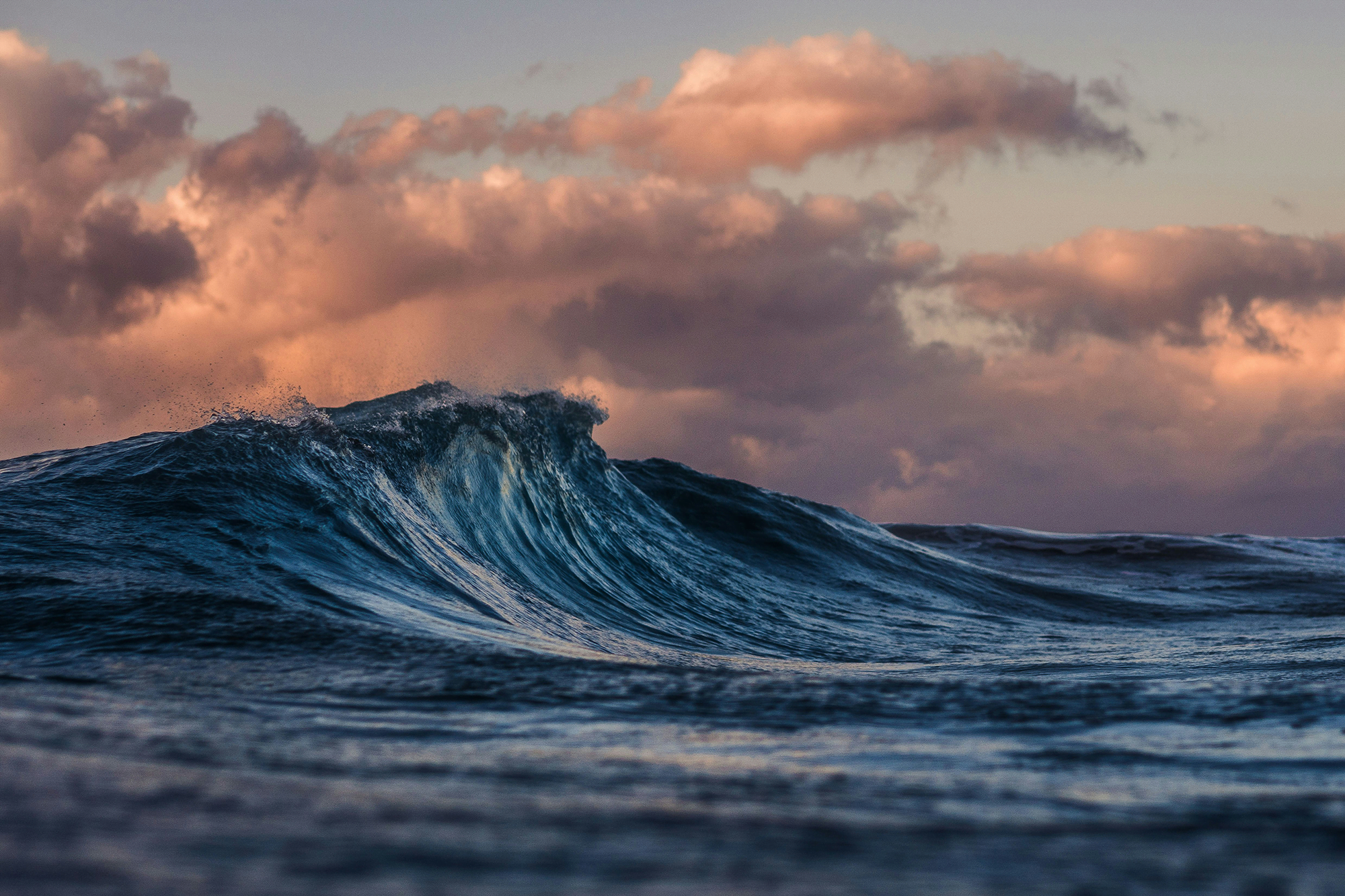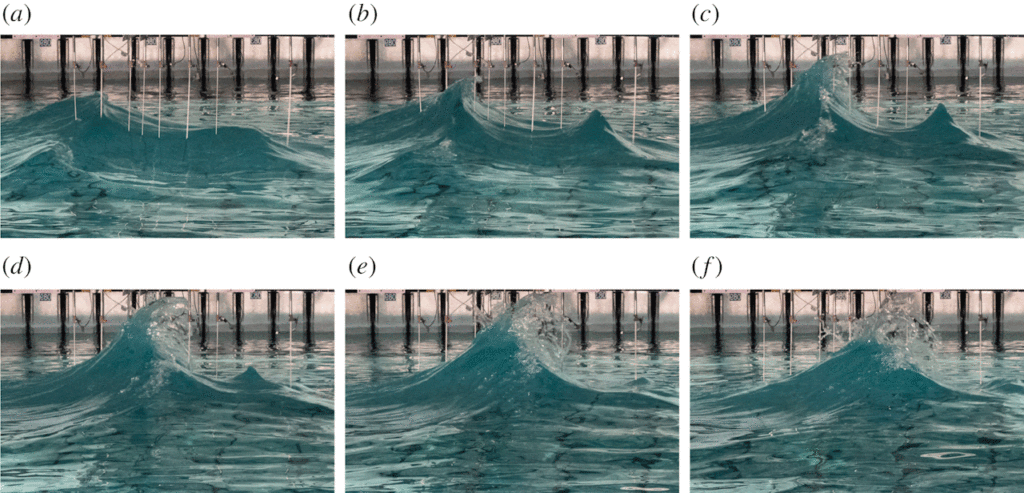Many models for forecasting ocean waves simplify the physics by assuming that waves are essentially two-dimensional, like a long breaker heading toward shore. But in the open ocean, waves often come from more than one direction; crossing seas are a good example. When waves from different directions combine, a recent study shows, the resulting wave can grow far larger and steeper than expected. These monstrous rogue waves are especially dangerous for offshore infrastructure like oil rigs and wind turbines, which must be built to withstand rare but extreme waves. (Image credit: O. Мороз; research credit: M. McAllister et al.; via Gizmodo)
Tag: rogue waves

Seeking Rogue Wave Origins
Rogue waves — rare waves much larger than any surrounding waves — have long been a part of sailors’ tales, but their existence has only been confirmed relatively recently. The exact mechanisms behind them are still a matter of debate. Laboratory experiments with mechanically-produced waves have created miniature rogue waves, but we still lack real-world observations of their formation.
To that end, researchers sailed the Southern Ocean, known for its rough waves, during austral winter and observed the state of the wind and waves nearby using stereo cameras. They found that young wind-driven waves tend to be steeper, and they move slower than the wind, as they’re still drawing energy from it. Older waves, in contrast, were shorter, less steep, and less likely have white caps from breaking. Overall, they found that strong winds could more easily drive young waves into the nonlinear growth that leads to rogue waves. (Image credit: S. Baisch; research credit: A. Toffoli et al.; via APS Physics)

Rogue Waves
After centuries of tales from sailors, in 1995 the Draupner off-shore platform recorded the first ever evidence of a freak wave – a single, wall-like wave steeper and taller than any other waves around it. Theories have been tossed back and forth for the last quarter century as to how the Draupner wave formed, but now a group of researchers report they have recreated a lab-scale version of this is famous wave.
They did so in a wave pool by making two smaller groups of waves cross one another at about 120 degrees (top). The interaction of those wave packets generated a much larger, steeper wave (bottom image sequence) that matched the profile of the Draupner wave. Recreating this past freak wave confirms that wave-crossing can lead to freak waves, which will hopefully help us forecast when conditions may be right for more to occur. (Image credit and research credit: M. McAllister et al., source; via Motherboard; submitted by Kam-Yung Soh)

Rogue Wave Recreated

If you look online, the term “rogue wave” gets thrown around a lot – a whole lot. And most of the videos you see of “rogue waves”, “freak waves”, and “monster waves” are just, in fact, big waves. What makes a deep-water ocean wave a rogue, scientifically speaking, is that it is extreme compared to its surroundings. One definition requires that a rogue wave be more than twice as tall as the height of average large waves in the area – like the rogue that takes out the Lego boat above. Outside the lab, this is a rare event – fortunately – because a true rogue wave has tremendous destructive power and seems to appear out of the blue.
This seemingly unpredictable behavior is thought to arise from nonlinear interactions between waves. Essentially, under the right conditions, a rogue wave grows monstrously large by sucking energy out of other surrounding waves. One way to try and predict rogue waves is to measure all the waves nearby and simulate their potential nonlinear interactions computationally – but this is time-consuming and requires a lot of computing power.
Instead, researchers have developed an alternative method, illustrated in the time series above. Instead of considering the rogue potential for all waves, they identify waves with characteristics that make them more likely to go rogue and focus on simulating those waves. In the animation, the wave packets are colored from green to red based on their increasing likelihood of turning into rogue waves. The algorithm is simple enough to run quickly on a laptop and can provide a couple minutes of warning to a ship’s crew – enough time to batten down before the wave hits. (Image credits: simulation – T. Sapsis et al., source; experiment: N. Ahkmediev et al., source; via The Economist and MIT News; submitted by 1307phaezr)

4th Birthday: Rogue Waves
Rogue waves—individual, isolated waves far larger than the surrounding waves—were reported for centuries by sailors. But their stories of massive walls of water appearing in the open ocean were not corroborated until 1995 when a rogue wave struck an offshore platform. How these giant waves form is still under active research, but one leading theory is that nonlinear interactions between waves allow one wave to sap energy from surrounding waves and focus it into one much larger, short-lived wave. I first learned of rogue waves during a seminar in graduate school. At the time, this idea of nonlinear focusing had only been explored in simulation, but a few years later a research group was able to demonstrate the effect in a wave tank, as shown in the video above. Wait for the end, and you’ll notice how the rogue wave that takes down the ship is much larger than its predecessors. For more on rogue waves and their mind-boggling behavior, be sure to check my previous post on the subject. (Video credit: A. Chabchoub, N. Hoffmann, and N. Akhmediev)

Rogue Wave Recreated
For years, mariners have reported occurrences of rogue waves–sudden, isolated waves many times larger than the surrounding surface waves. Until 1995, when a rogue wave was first measured, debate raged as to whether such waves even existed. Scientists have since agreed that nonlinear models of wave interaction are the most likely source of the amplification necessary to create rogue waves. Since the Navier-Stokes equations that govern hydrodynamics are so difficult to solve, scientists have looked to simpler nonlinear wave equations, like the nonlinear Schroedinger equation that governs optics, to generate rogue-wave-like behavior. While the equation gives insight into how a given wave system will evolve, it is still necessary to determine what initial conditions can lead to the formation of a rogue wave. All manner of random conditions exist in the ocean, but to recreate the behavior in a simplified system, we must know which initial conditions are the right ones. Akhmediev et al presented a theoretical perspective on the initial conditions that might lead to rogue wave amplification, and now, for the first time, researchers have been able to create a rogue wave in a wave tank. That little blip that sinks the Lego pirate ship is a great accomplishment toward understanding a phenomenon whose very existence was in question less than twenty years ago. (Video credit: A Chabchoub, N Hoffmann, and N Akhmediev; via Gizmodo; for more, see APS Viewpoints and Akhmediev et al)






